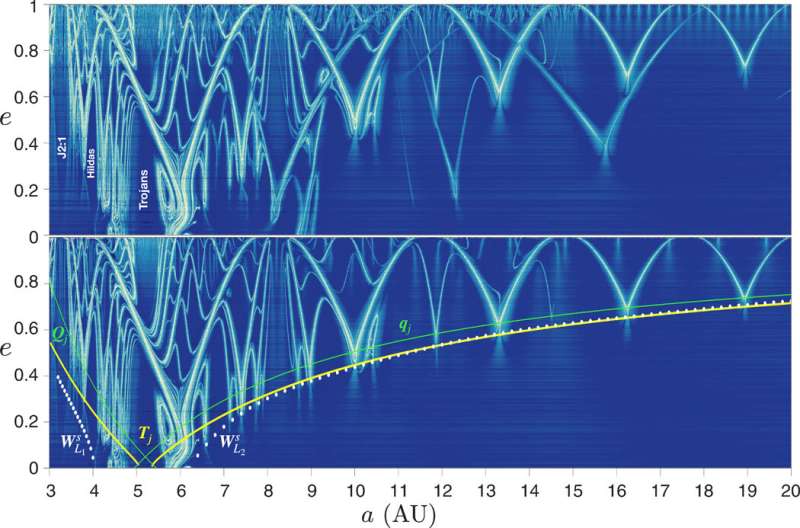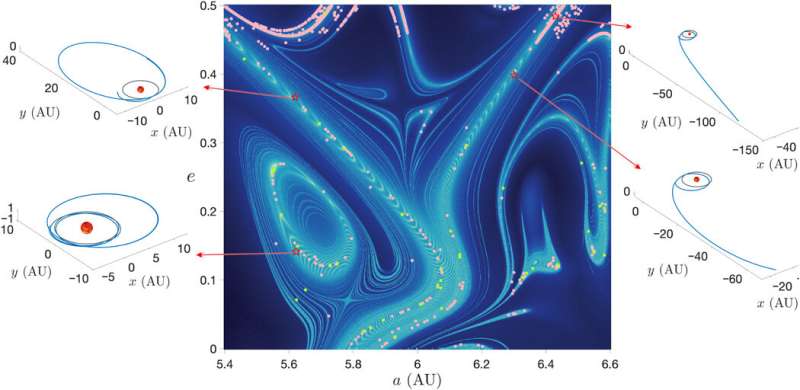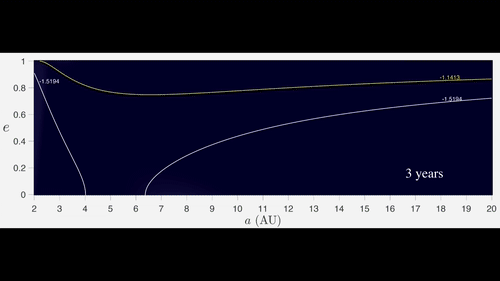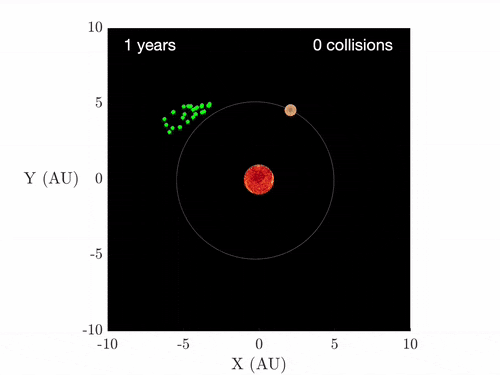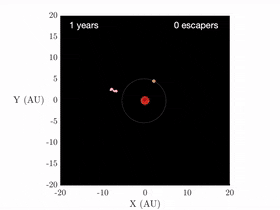Global arch-like structure of space manifolds in the Solar System. Short-term FLI maps of the region between the outer edge of the main asteroid belt at 3 AU to just beyond the semimajor axis of Uranus at 20 AU, for all elliptic eccentricities, adopting a dynamical model in ORBIT9 that contains the seven major planets (from Venus to Neptune) as perturbers (top) or Jupiter as the only perturber (bottom). Orbits located on stable manifolds appear with a lighter color, while darker regions correspond to trajectories off of them. Three sets of dynamical boundary curves are superimposed on the map in the bottom panel corresponding to the perihelion (qj) and aphelion (Qj) lines of Jupiter (thin, green), the contour of Jupiter Tisserand parameter Tj = 3 that dichotomizes asteroids and comets (thick, yellow), and the stable manifolds of L1 (WsL1) and L2 (WsL2) (dotted, white). The map samples more than 2 million initial values of (a, e), where the initial inclination i, argument of perihelion ω, and longitude of ascending node Ω are set equal to that of Jupiter at the initial epoch 30 September 2012. The initial mean anomaly of the TPs is set to 60° ahead of Jupiter in its orbit to reflect the “Greek” L4 configuration. a, semi-major axis; e, eccentricity. Credit: Science Advances, doi: 10.1126/sciadv.abd1313
Space manifolds form the boundaries of dynamic channels to provide fast transport to the innermost and outermost reaches of the solar system. Such features are an important element in spacecraft navigation and mission design, providing a window to the apparently erratic nature of comets and their trajectories. In a new report now published on Science Advances, Nataša Todorović and a team of researchers in Serbia and the U.S. revealed a notable and unexpected ornamental structure of manifolds in the solar system. This architecture was connected in a series of arches spreading from the asteroid belt to Uranus and beyond. The strongest manifolds were found linked to Jupiter with profound control on small bodies across a wide and previously unknown range of three-body energies. The orbits of these manifolds encountered Jupiter on rapid time-scales to transform into collisional or escaping trajectories to reach Neptune's distance merely within a decade. In this way, much like a celestial highway, all planets generate similar manifolds across the solar system for fast transport throughout.
Navigating chaos in the solar system
In this work, Todorović et al. used fast Lyapunov indicator (FLI); a dynamic quantity used to detect chaos, to detect the presence and global structure of space manifolds. They captured the instabilities acting on orbital time scales with the sensitive and well-established numerical tool to define regions of fast transport in the solar system. Chaos in the solar system is inextricably linked to the stability or instability of manifolds forming intricate structures whose mutual interaction can enable chaotic transport. The general properties can be described relative to the planar, circular and restricted three-body problem (PCR3BP) approximating the motion of natural and artificial celestial bodies. While this concept is far from being fully understood, modern geometric insights have revolutionized spacecraft design trajectories and helped build new space-based astronomical observatories to transform our understanding of the cosmos.
The dynamics of space manifolds that allow the grand tour of the solar system via an interplanetary transport network has also contributed to the transit mechanisms of the Jupiter-family comets (JFCs). The JFCs are the evolutionary products of trans-Neptunian objects that continue to evolve through the giant planet region as Centaurs and into the inner solar system. Cometary and asteroidal bodies occupying orbits in the region between Jupiter and Neptune and Centaurs are dynamic and unstable with lifetimes of only a few million years. Astrophysicists usually use vastly diverse time scales to model detailed dynamic pathways that connect different time zones of the outer solar system.
A finer image of the manifolds with colliding and escaping objects along them. A highly resolved, 1500 × 1500 point, Jovian-minimum-distance map concentrated near the largest V-shaped chaotic structure, made using Mercurius with an integrator time step of 0.01 (equivalent to around half a day). Contained in the map is a finer image of the manifolds, where we notice small substructures wrapping around the main ones. Superimposed on the stability map are the orbits that collide with Jupiter (green dots) and all escaping trajectories (pink dots), whose dynamical transitions from elliptic to hyperbolic have been further validated by significantly increasing the tolerance within Mercurius (using a step size of 1 min). Example evolutionary states of four initial conditions (red stars) located on the structures are shown in Cartesian coordinates in the callouts, where the heliocentric orbit of Jupiter is also shown for reference (gray). The specific escaping trajectory in the top right corner was further investigated using the more realistic seven-planet model, finding that it indeed reaches more than 100 AU in less than a century in its unbounded evolution. Animations of collisional and escaping orbits are given. Credit: Science Advances, doi: 10.1126/sciadv.abd1313
Greeks and Trojans—the global structure of space manifolds
Todorović et al. considered the short-term (100-year) evolution of massless test particles (TPs) located on orbitals between the main asteroid belt and Uranus. They presented the data in dynamic maps based on two widely used orbit integration packages ORBIT9 and REBOUND while developing a force model containing seven major planets from Venus to Neptune as perturbers alongside the Sun/Jupiter/test particle three-body system. Co-orbital asteroids known as "Greeks" and "Trojans" followed the same orbit as Jupiter but led or trailed the planet by an angular distance.
The team computed the FLI (fast Lyapunov indicator) across 100 years for a large grid, where lighter regions represented orbits located on stable manifolds and darker regions represented those away from them. The researchers noted an emergence of a large "V-shaped" chaotic structure connected to a series of arches at increasing heliocentric distances and nearly following the Perihelion line of Jupiter. The stable manifolds led to chaotic motion due to complex interactions with the corresponding unstable manifolds. These manifolds were analytically highly complex. Furthermore, as expected, Jupiter was the dominant perturber of the system and responsible for the majority of the rich chaotic architecture—tracked all the way beyond Neptune.
Global appearance of space manifolds in one century Jovian-minimum-distance maps computed over roughly ten orbital revolutions of Jupiter with each frame of the animation showing how the arches and foliated substructure manifest over three-year increments. Each map samples four million initial values of semi-major axis and eccentricity, where the initial inclination, argument of perihelion, and longitude of ascending node of the TPs are set equal to that of Jupiter at the initial epoch 30 September 2012. The initial mean anomaly of the TPs is set to 60° ahead of Jupiter in its orbit to reflect the Greek L4 configuration. Two contours of Sun-Jupiter-TP three-body energy are superimposed, with -1.5194 corresponding to the value of the L1 Lagrange point. The map covers the inner edge of the main asteroid belt at 2 AU to just beyond the semi-major axis of Uranus at 20 AU. The Mercurius package within REBOUND was used under the Sun-Jupiter-TP three-body model. Credit: Science Advances, doi: 10.1126/sciadv.abd1313
Rapid scattering and collisions, followed by the Centaur: Jupiter-family comets orbital gateway
To understand the dynamics of manifold- and close-encounter physics in the system, Todorović et al. used software packages to accurately track evolutions through close approaches with Jupiter. Using Jovian-minimum-distance maps for the Greek and Trojan orbital configurations, the team showed how all orbits along the chaotic structures entered Jupiter's Hill sphere during the course of their evolution. To understand close encounter dynamics, the team investigated Lagrange equilibrium points (L1 and L2), which define positions in space where the gravitational pull of two large masses precisely equalled the centripetal force required for a small object to move with them. All close-encounter trajectories visited the neighborhood of either L1 or L2 Lagrange points, casting light on the poorly understood Greek-Trojan dichotomy of escaped Jupiter Trojan asteroids.
Small bodies located on manifolds that lead to rapid collision with Jupiter Heliocentric-ecliptic inertial frame evolution of the 31 colliding TPs. The fastest collision occurred in just over seven years and the average collision time was roughly 36 years. Credit: Science Advances, doi: 10.1126/sciadv.abd1313
Among the test particles (TPs) approaching Jupiter, a few dozen directly collided and their Jovicentric distances became less than Jupiter's radius. Nearly 2000 TPs transitioned from bound elliptical orbits to unbound hyperbolic escape orbits as a result of manifold-induced encounters. The transitioning orbits then reached Uranus and Neptune within 38 and 46 years; the fastest test particles arrived in the Neptunian region under a decade. Scattering or collision with Jupiter was at least several orders of magnitude shorter than those previously reported. Todorović et al. next observed the path of comet 39P/Oterma based on previous work conducted more than two decades ago, where the comet closely followed the invariant manifold structures associated with L1 and L2. The work showed how the invariant manifolds were the true orbital gateway that seemed to influence the low-inclination orbits closer to the Lagrange points of outer planets.
Small bodies located on manifolds that lead to fast escape from the Solar System Heliocentric-ecliptic inertial frame evolution of a subset of 38 escaping TPs. These elliptic-to-hyperbolic transitioning orbits reach the distances of Uranus and Neptune in roughly 38 and 44 years on average, respectively, and 63% of them get kicked to 100 AU over the course of a century. Credit: Science Advances, doi: 10.1126/sciadv.abd1313
Outlook on chaotic transport
In this way, Nataša Todorović and colleagues reported manifolds that act across orbital timescales of several decades in this work, in contrast to the tens to thousands of millions orbital revolutions that are traditionally considered. Additional information through quantitative studies will provide deeper insights into the transport between the two belts of minor bodies and the terrestrial planet region. The team expect to combine these observations with theory and simulations to improve the existing understanding of celestial transport. The observed effect of Jupiter-induced, large-scale transport on a decadal time scale is no surprise, since space missions have been historically designed for Jupiter-assisted transport, including flybys of Voyager 1 and Voyager 2.
Researchers have discovered a new superhighway network to travel through the Solar System much faster than was previously possible. Such routes can drive comets and asteroids near Jupiter to Neptune's distance in under a decade and to 100 astronomical units in less than a century. Accordingly, they could be used to send spacecraft to the far reaches of our planetary system relatively fast, and to monitor and understand near-Earth objects that might collide with our planet.This video shows the global arch-like structure of space manifolds in the Solar System. The map shows the region between the outer edge of the main asteroid belt at 3 AU to just beyond the semi-major axis of Uranus at 20 AU. Orbits located on stable manifolds appear in a lighter color. Credit: University of California San Diego
More information: Nataša Todorović et al. The arches of chaos in the Solar System, Science Advances (2020). DOI: 10.1126/sciadv.abd1313
Nataša Todorović. The precise and powerful chaos of the 5:2 mean motion resonance with Jupiter, Monthly Notices of the Royal Astronomical Society (2016). DOI: 10.1093/mnras/stw3070
Jérôme Daquin et al. The dynamical structure of the MEO region: long-term stability, chaos, and transport, Celestial Mechanics and Dynamical Astronomy (2016). DOI: 10.1007/s10569-015-9665-9
Journal information: Science Advances , Monthly Notices of the Royal Astronomical Society
© 2020 Science X Network
